Indian Food, American Foodie
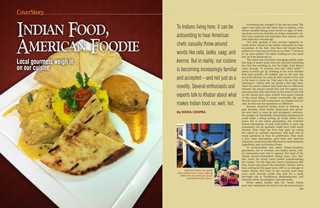
Local gourmets weigh in on our cuisine
To Indians living here, it can be astounding to hear American chefs casually throw around words like raita, tadka, saag, and keema. But in reality, our cuisine is becoming increasingly familiar and accepted—and not just as a novelty. Several enthusiasts and experts talk to Khabar about what makes Indian food so, well, hot.
Something has changed in the last ten years. The signs come hard and fast these days in Atlanta, a city whose enviable dining scene shows no signs of slowing down and now includes an Indian restaurant culture more nuanced and expansive than anyone could have expected a decade ago.
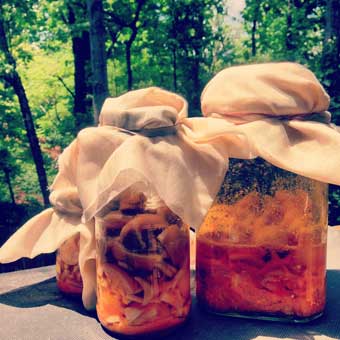
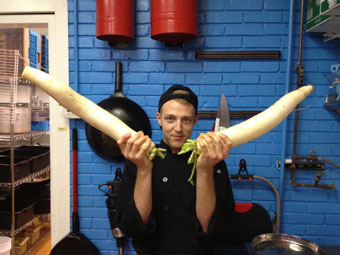
Chef Daniel Peach, who speaks Hindi and has been to India, whips up pickles that can remind you of your grandmother’s fiery achaar.
The shift, gradual at first, became apparent recently when I dined at two Indian restaurants in close succession. At the first, Chai Pani chef Daniel Peach pulled out a chair and sat down at our table. “Y’all want to try some pickle?” he asked, holding out two small jars. As if we would say no.
The achaar was a turmeric-and-ginger pickle made two ways. It wasn’t quite done yet, was just something the chef was working on, but the bright, bold flavors came through. “Is turmeric root also called haldi?” I asked as Peach got up, thinking of the more familiar fiery-hued powder. He nodded, and on his next trip out of the kitchen, he came by with a hunk of the root in his hand to show me. This was a far cry from the restaurant I visited with my family a few days later, when the server insisted that there was no difference between the special masala dosa and the regular masala dosa (then why have both on the menu?) and told us the cheese dosa came stuffed with paneer instead of the actual filling of melted mozzarella. My order was the same at both restaurants: an uttapam and hot chai. So why was the experience so different?
Because America’s dining scene is evolving. In past decades, when Indian restaurants and groceries were hard to come by and immigrant communities sought out familiarity, enterprising entrepreneurs could make a living serving up cheap dishes from home. But to the newer generations, the contrived formal atmosphere of strip mall buffets or pure veg restaurants run by apathetic staffs don’t hold much interest. They crave the food they grew up eating but expect an updated experience and have just as many questions as they do preferences. They want a nice, clean atmosphere, good food, and expected American conventions like table service, fresh seasonal ingredients, and cool bottles of beer.

John Kessler recently went to southern India, where his daughter works. The AJC’s food critic loved the Keralite restaurants he went to for their fresh ingredients, but he says that in Atlanta also we have good Indian dining options.
To accommodate that newer Indian-American generation, not to mention non-Indian diners, Indian restaurants have had to regroup. The head of the Atlanta Journal-Constitution’s dining team, John Kessler, noted the recent trend toward mainstreaming the cuisine. “On the high end, there’s Cardamom Hill; then there’s also places like NaanStop.” Kessler, who’s been writing for the paper since 1997, is no stranger to Indian flavors. He’s been to the country more than once, most recently earlier this year for a quick five-night trip to Pondicherry, Mahabalipuram, and Chennai, where his daughter currently works.
When asked, Kessler said the “South Indian pure veg” restaurants he tried on his trip seemed quite similar to the ones here in town. “Honestly, I think some of the dosas at Madras Bhavan were better than some I had in India.” The big population of Indians, specifically Gujaratis and Tamils, contributes to the large Indian presence in Atlanta’s dining scene, Kessler noted. “I think Indian and Korean are two types of cuisine in the city in which the food is closer to home than it is for a lot of other international groups. If you like to explore ethnic cuisines, Indian food is one of the best and most interesting in Atlanta.”
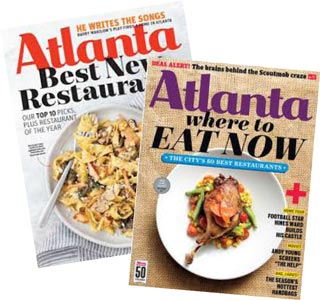
Food writer and critic Christiane Lauterbach of Atlanta Magazine and Knife & Fork finds it interesting that Indian restaurants typically have not been concentrated to the extent that Korean and Chinese restaurants can be. They open all over the metro area, so they’re not as easy to lump and discover. She believes the addition of Global Mall was an “important cultural marker” in terms of growth and visibility to the non-Indian community. Developments like that and Patel Plaza “make it easier to simply recognize Indian restaurants.”
Breaking of cultural barriers
Though the desi restaurant community can appear fragmented in terms of location, Lauterbach believes Indian restaurants have broken into the American
culinary scene. “With the opening of restaurants like Chai Pani and Cardamom Hill, cultural barriers have been broken,” she said. “I think it’s a very important
moment when a restaurant transcends its ethnic
community.” Lauterbach, herself a fan of places like
Zyka and Lazeez Tava Fry, appreciates hole-in-the-
wall authentic eateries but also knows that the audience for international cuisine is changing. It can be difficult, she acknowledged, to attract a wide audience of Americans to Indian restaurants. However, she’s seen that sophisticated diners and people who seek out new food and experiences “respond well to this new prominence of Indian cuisine.”
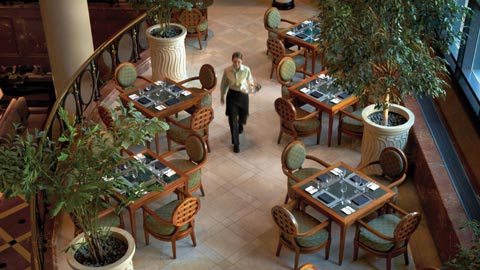
At the venerable Four Seasons Hotel in midtown Atlanta, you’ll find items like chicken tikka masala, malai kofta, and meen moilee even on the regular menu.
As Four Seasons Hotel Atlanta executive chef Robert Gerstenecker added, the successful addition of so many international restaurants shows that the city is “a melting point market for all these different cuisines,” mentioning in particular a newcomer to his busy neighborhood, Tabla. “It’s based on small plates, but the flavors are very appropriate and approachable for this market.”
In the center of Midtown, Gerstenecker runs the kitchen for the entire Four Seasons. He started cooking Indian food professionally seven or eight years ago, when the hotel began to get inquiries about Indian weddings. “Not having a history in Indian food, I was anxious, but the first mother of the bride said she’d come into the kitchen and help me out, making sure everything was okay.” After that interaction, he realized it’s more about learning a different way to cook. “It’s not so much about the recipe, it’s really about how you treat the ingredients and what you do along the way.”
He’s attracted to the mystery behind Indian cuisine. “You give a recipe to a cook uneducated in Indian food, and the food’s going to come out totally wrong, simply because of the amount of toasting and when to add ingredients—it’s really important to know that process.” Gerstenecker now services busi ness groups in addition to weddings, and commonly requested dishes from event managers include palak paneer, mango lassi, and rice pulao, plus vegetable jalfrezi and fried tempura vegetables—known to the initiated as pakoras. “What I like to add to the menu are things like chole bature, with the big pillowy bread, and malai kofta, another favorite. Lamb rogan josh is popular, and of course the chicken tikka masala.”
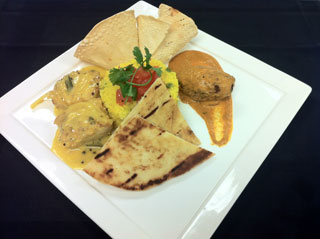
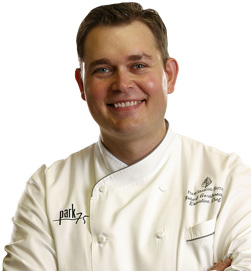
Chef Robert Gerstenecker and a couple of his signature Indian dishes. (CatMax Photography)
Given the favorable reception, Gerstenecker often includes Indian dishes on the regular menu. He deemed the chicken tikka masala, which he calls an entry-level dish because of its recognizable flavors, “comfortable for the Western palate.” Other recent specials include malai kofta and meen moilee served with golden rice.
“We like using a global approach to our specials, because we have a big mix of people in the hotel, and it opens up [the cuisine] to locals and guests.” The chef stays away from anything too spicy, choosing to focus on flavor rather than heat. “Some Indian spices can be difficult to handle if you’re not used to them—some are very regional—and the flavors are very pronounced.”
The pronounced flavors cause some people to avoid the cuisine. “The strong smells can turn some business people away, but that’s exactly what I like and what attracts me to Indian food—those strong, flavorful ingredients,” said Gerstenecker. John Kessler’s experience is similar. “The smells are so permeable that it’s not for everybody. It’s the same as when people can’t deal with the fermented flavor of kimchi in Korean food,” he said. “It’s not strongly pungent, but it’s permeable— you’re enveloped in it, so you have to give in. That’s not for some people, but Indian food is so delicious. Once you understand it a bit more—the more you eat it, the more you love it.”
When asked how his AJC readers react when he writes about Indian food, Kessler said, “It’s interesting because we get a lot of Indian readers who pipe up when we write about it.” They’ll recommend other restaurants, talk about which ones serve “real” Indian cooking like their ammas made back home, and have strong opinions about which versions of dishes like dosa are the best. “When we write about an international restaurant, we don’t get as big a hit as we do with more mainstream restaurants, but the people who read it are really into it.”
Depths and layers
What attracts Kessler to Indian food? “There are
different ways to answer that question, but the most
noble one is that it’s very layered cooking. Indian
cooks spend a long time building flavors. They cook
the onions just the right way to get those base notes,
then they might hit a daal with the tadka (spice-flavored
oil) to get the right cumin or mustard seed
or nigella seed flavor on top. They understand that
some flavors come from underneath and some are
right on top. I think very few world cuisines get that
as well.” On the other hand, “if you’re sitting down with
a big pile of bhel puri, it’s just something that you want
to inhale—it’s so good.”
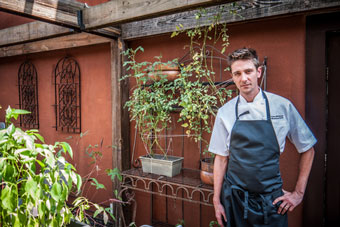
Chef Tyler Williams often uses Indian methods and flavors to create dishes that are not Indian, but Indian-inspired.
Tyler Williams, the executive chef of Buckhead fine dining spot Woodfire Grill, often incorporates Indian techniques and tastes into his food, even though the outcome may not be truly Indian dishes. He’s attracted to the cuisine by the “complexity of building depths of flavor with spices.” European-trained chefs, he noted, can sometimes underutilize spices because of the limited French-taught pantry. As far as Indian spices go, “you can use that technique of building complex flavor and balance, as well as the depths you create—you can bring all that to your dish and it can have nothing to do with Indian cuisine, per se.” It’s a technique, like when the chef uses tadkas to finish pots of greens because it’s what he’s looking for in the final product. “It just gives you more tools to play with.”
“There’s a lot more variety to the vegetables and ingredients that we use here than our Southern palates know,” Williams adds. Consider okra. It’s well-loved in the South, but it’s prominent in numerous cultures. “I like a chaat with it,” the chef said, so he juliennes the okra, fries it crispy, then tosses it with red onions, tomato, cilantro, roasted cumin, lemon juice, and chaat masala. He serves that with a local yogurt that he turns into raita with summer cucumbers and tomatoes. “It’s all seasonal and it’s all Southern ingredients, it’s just that the flavor profile is Indian.”
At Woodfire, Williams makes paneer in-house, too, because he likes to press ricotta so that he can grill it. One version of the dish included saffron, cardamom, and white pepper with the paneer, which was then grilled and served as a vegetarian entrée over a mustard green saag. “Using a French technique, I made an artichoke sauce, then used that as the cream that I cooked down over the mustard greens with caramelized onions, a really nice base of curry leaf tadka, and tons of asafetida.” And at a food festival in March, he served keema and curried spring peas on steam buns using local whole ground lamb from southern Georgia’s White Oak Pastures.
Said Williams, “I use this stuff regularly, but I don’t claim to be making Indian food. I say, ‘This is the flavor I want, this is the ingredient I have, and this is the final product I want to put forward.’ I’m not working off of any specific dish; I’m working off the ideas of Indian dishes and associated flavors.”
Is Indian “in”—like sushi?
Williams equated Indian cuisine to sushi, which has caught on in such a cross-cultural fashion. “I
think we’re getting there with Indian food, I really do. There’s not a lot of confrontation when you tell your friends you want to go out for Indian like there used to be.” He brought up the Chipotle-style Indian restaurants that have started to open across the U.S.,
the kind where you take naan and load it with the
meat and toppings of your choice. “It would be fantastic to open something like that—are you kidding me?
I love a tandoori oven. I had to shave my hair down
real short, though, because when it was longer and I started working the tandoor, I’d lean over the opening over the top and it would just char my hair off.”
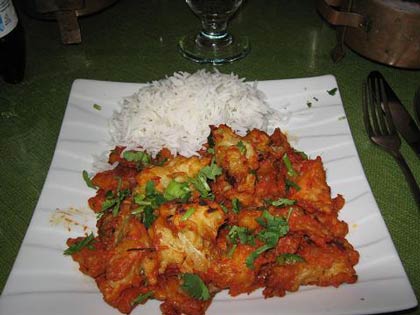
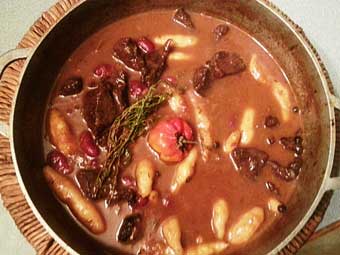
Jamaican dishes presented by Chef Omar Powell.
Omar Powell, the one-time chef de cuisine of Asha Gomez’s Cardamom Hill, drew easy parallels between the restaurant’s Keralite themes and his own background, because, as he said, the landscapes of Jamaica and southern India are almost identical. In both regions, mangoes, coconuts, sugarcane, and bananas are abundant—and just like in Kerala, Jamaicans use a lot of black pepper, nutmeg, cinnamon, and star anise. “Cardamom was not a big part of our cuisine in Jamaica, I must say, but it’s something we adopted real fast,” Powell said. “Even though I had a classical French culinary background, learning the cuisine of Kerala was an easy transition for me because of my heritage.”
When Kessler was recently in southern India, he relished the Keralite restaurants he went to because of their fresh ingredients. “They used fish from the backwaters and all these things like fresh green peppercorns for curry. So delicious—I just loved it.”
Once he came to the United States, and New York in particular, Omar Powell was exposed to the other side of Indian cuisine. “I learned different food from different areas—the whole tandoori idea and concepts like that came into my experience.” In terms of how Indian food fits into the Atlanta dining scene, Powell believes “it takes some creativity and some sense of bravery to take it to where it can or should be.” He explained, “In America, we’ve been exposed to mostly northern Indian cuisine. But India is a massive, massive land, and it has extremely dynamic food and dynamic cooking techniques.”
“For me, growing up in Jamaica, India meant roti, but it means something else to somebody here in the U.S.,” Powell said. “America is definitely a canvas upon which India can put together a wonderful display of what it has to offer. It is a very old culture with a rich history, and it’s been around for way longer than a lot of the cultures that have their cuisines celebrated right now.”
“Areas like Kerala have a whole different culture that doesn’t necessarily translate into everything else that we as Americans have been learning about India,” Powell said. This also holds true for the southern coastal city of Pondicherry, with all of its French influences. “When Americans think of Pondicherry, it’s not something that screams India right away, but it is India.”
Gerstenecker has always wanted to go to India because of the culture and the food. “There’s a misconception. People think Indian food is Indian food, but there are so many different states and regions and there’s so much to explore. You don’t do it justice by saying, ‘Oh, Indian food is all curries.’” He added, “That’s a word that we misuse so much. If people really knew the amount of passion and effort it takes to cook that food, I think they’d have a different perspective.”
When Williams lived in Chicago, he noticed the same thing. “I went to Devon Avenue constantly. It was different because the restaurants were region-based—they were all different from each other. It was amazing to explore the possibilities of that.”
“Indian food is penetrating the mainstream,” the Woodfire Grill chef believed. “People now have the option to eat not just Indian food, but specific Indian food like Bombay street cuisine, which will open up a less intimidating way to try things.” The biggest thing, he said, is getting people to jump the hurdle of hesitation. “Once they get those flavors in their mouth, they’re going to be excited about it. It’s phenomenal food.”
Daniel Peach started at Chai Pani at the age of nineteen. Now in his mid-twenties, the American chef, born and raised in South Carolina, is fluent in Hindi—he can read and write it, too—and has an arsenal of traditional Indian dishes at his disposal thanks to his dedicated studies of the cuisine and his multiple trips traveling across the country.
“I’d had Indian food before I cooked Indian food, and everybody thinks it’s naan, saag paneer, and tandoori chicken. I’ll eat those any day and love it, but you can’t eat that every day—and Indian food is eaten every day, it’s a family experience,” Peach pointed out. “It’s so important, especially to aunties. They’re already talking about tomorrow’s breakfast for uncle and next week’s lunch.”
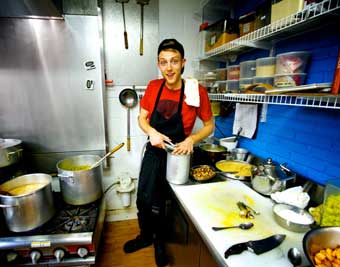
Peach notes that Indian cuisine is expanding people’s palates—and even their worldview.
Social implications
Peach believes the emergence of Indian cuisine as an accepted part of the food scene in America has given people more than just a taste of a different
ethnic flavor. “It’s expanding people’s palates, and
if you really think about it, it’s expanding their worldview. Because it’s so easy to limit a certain race or
nationality of people if you don’t know anything
about them.” There are social implications beyond
the food, Peach pointed out. “You can think, ‘Oh, they all just eat curry.’ Of course that limits their cuisine,
but it also limits them as people, and India’s more
diverse than any place on earth.”
“It’s hugely diversified,” Lauterbach said, noting the vegetarian and non-veg restaurants, the Mughlai cuisine and South Indian fare, the sweet shops and thali menus. “It may not be easy for non-Indians to understand at first, but that’s when a cuisine begins to really sing and resonate, when you have this diversification instead of one all-purpose menu.” She added, “Now, even less sophisticated eaters have started to understand that Indian cuisine is vast and incredibly varied.” She—and her readers— find that exciting. Peach notes that Indian cuisine is expanding people’s palates—and even their worldview.
What is “authentic”?
Because Peach is a white male cooking Indian food, some people automatically perceive
his fare as non-authentic. “But I know my food is authentic—
I cook my sabji exactly like I
learned from aunties in India.
We did a Bombay club sandwich that’s as authentic as Mumbai gets. That’s Mumbai street food, but it’s a club sandwich. On white bread, on the cheapest bread you can buy. And that’s just as authentic as saag paneer.”
“It means being true to yourself, being real,” Chef Peach explained. It’s more authentic for the restaurant to make pakoras out of kale, which grows here most of the year, than it is to make something like a palak pakora, which Peach used as an example since local spinach can be harder to find due to the southern U.S.’s brutal summers and cold winters.
The fluidity of the word authentic makes more sense when it’s looked at in terms of India’s regional cuisines. In addition, there’s the technique aspect: “Tadka, tandoor, tava, the different utensils and procedures we use. But in terms of the finished product, I don’t think the finished product defines the authenticity of the food. I think the authenticity is in the ingredients and the message.”
Said Peach, “I know some restaurants in the U.S., especially in the New York and New Jersey area, they’re not run as chef-driven or food-focused ventures. They’re run as businesses. They cut corners wherever they can, they serve on disposable things, and it’s just kind of barebones. You know that style. Say you order dosa, bhel puri, and pav bhaji. You sit down, they call your pav bhaji, you get up, you go get it, you sit down. As soon as you sit down, your bhel puri is ready. They call your dosa, same thing.” Peach enjoys that and finds it nostalgic of his time in India. “But to connect with where we live, in America, and to serve people, you have to fit a different mold,” he said.
“That trend toward more upscale, savvy Indian restaurants is exciting to me in many ways,” said Lauterbach, who added that Atlanta is aligning itself with bigger cities “which have all entered that modern world where you have to appeal to the diner with more than just a collection of spices.” In her print newsletter Knife & Fork, she recently gave Emory-area restaurant Biryani Pointe a positive review. “There should be more places like that—really modern in their outlook, very traditional in their spicing. They really bring Indian cuisine forward in a good context.”
“The only people who don’t like [Indian food] are the people who’ve had something too spicy,” said Peach. “If you give them the right thing, they love it. Dahi puri? Everybody loves dahi puri. There’s something in India for everybody, especially in terms of food. It’s such a vast cuisine. Everybody loves naan, everybody loves a crispy dosa.”
Atlanta-based Sonia Chopra is the Cities Editor at Eater.com and a freelance writer.
COMING SOON: Our interviewees share their favorite Indian recipes. Meanwhile, here is more on Omar Powell.
India in America,
via Jamaica
Jamaican by heritage, classically trained chef Omar Powell learned how to cook Indian food at the Culinary Institute of America in New York. Jamaica’s motto “Out of many, one people” manifests in the nation’s cuisine, he noted. “We curry everything in Jamaica, because after slavery was abolished, paid laborers came in from India, and they brought their food with them. They brought their spices, their ideas, and their cooking techniques, and we adopted those with what was available in Jamaica. It’s part of my background, my heritage.”
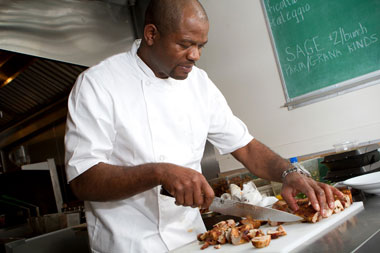
Chef Omar Powell. (CatMax Photography)
Even here in Atlanta, Jamaican restaurants offer approximations of Indian cuisine. “At any given time at a Jamaican restaurant, you’ll find a curried goat—we’re famous for our curried goat—or curried chicken on the menu. That’s the beauty of Jamaica itself: You’ll find our food representative of our country.” The chef’s newest project, a supper club called 1494, focuses on the cuisine of Jamaica and surrounding region. “At a certain point, curry became a huge part of the education of our palate, so we got to love and embrace it—we curry everything we can get our hands on.” Atlantans will find curry everywhere from the little hole-in-the-wall to Crescent Avenue’s Stir It Up in the middle of Midtown. “It’s a sense of giving homage, it’s our way of tipping our hats to the Indian contribution to our cuisine.”
It’s not just curry, either, though Powell noted that’s the first thing somebody could immediately recognize because of its predominance in Jamaican fare and in America’s Indian food culture. “We’ve also learned ways to cook our peas differently…India gave us a hand in how to represent the food that we have naturally produced there in Jamaica.”
Enjoyed reading Khabar magazine? Subscribe to Khabar and get a full digital copy of this Indian-American community magazine.
blog comments powered by Disqus










